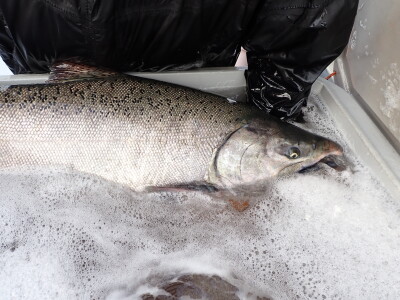Gulf/South Atlantic
IFQ fisheries fare well, oysters don't; spiny lobster, stone crab start slow
WINNERS
Red snapper and red grouper top the region's list of healthy, productive fisheries in 2012 thanks to good harvests and very strong prices.
Late in the year fishermen were reporting ex-vessel prices for red snapper in the $4.50 to $5.25 range and red grouper around $4. Both are managed under individual fishing quota programs with attendant advantages and problems, depending on one's point of view and whether one owns a decent number of shares.
"If you don't have enough quota, it's gotten to the point that it's very expensive" to participate in the fishery, says Madeira Beach, Fla., fisherman and boat owner Martin Fisher.
LOSERS
Vermilion snapper — sometimes vying for top overall snapper-complex value — in Florida, at least, have all but disappeared from some historic fishing grounds, leaving fishermen perplexed and uneasy.
For oysters, 2012 wasn't a good year in the Gulf of Mexico. Louisiana harvesters and lease owners still commonly report that they haven't been able to harvest much from areas affected by the 2010 BP oil disaster. Mississippi was still recovering from the oil spill and 2011 floods but finally got a fisheries disaster declaration (though no money yet) from the federal government. In Florida, low water levels in the Apalachicola River and related problems caused by high salinity in the bay all but stopped production in the state's primary oyster harvest area.
Summer flounder stocks are healthy and prices are decent, but Oregon Inlet, an essential passage for oceangoing trawlers, has shoaled to impassability at times during the past two years. Large portions of North Carolina's quota have been transferred to other states, leaving the state's dealers in dire straits and fishermen with a logistical nightmare and higher expenses. In December 2012, the Army Corps of Engineers reported the navigation channel was so shallow it couldn't even bring a dredge into position to try to open the channel.
ONES TO WATCH
Gulf shrimpers, looking to turn the corner on recent drought, flood, oil-spill, hurricane and price woes, didn't find what they were looking for in 2012. Through October, harvest levels were down slightly, according to NMFS data, and prices were generally flat or worse. News from the South Atlantic was worse, especially in South Carolina, where the winter white shrimp season was virtually nonexistent. Hilton Head shrimper Jeff Toomer says he thinks an especially virulent black gill disease episode may also have been weather-related.
"Any time it's a mild winter, it seems like it comes back more," Toomer said. "We thought we were through it when it didn't show up until October."
Florida Keys fishermen, who have been on a roll in recent years with remarkably good harvests and prices in the sister fisheries of stone crab and spiny lobster, were hoping to chalk up yet another good year. Spiny lobster started out very slow in early August, and stone crab, opening Oct. 15, was a near disaster into December.
Since the end of the year, however, both have picked up, said Bill Kelly, executive director of the Florida Keys Commercial Fishermen's Association. Kelly says fishermen and researchers think unusually warm weather contributed to unusual behavior and appearance patterns for stone crab and lobster.
"The consensus of opinion at this point is that climate and much warmer water temperatures — 10 to 15 degrees higher [than last winter] in some places" — have affected the fisheries, Kelly says. Unusually large numbers of octopi, which have a taste for stone crab, especially, continued to be a problem.
With cooler weather and two months to go for lobster and four for stone crab, Kelly is hopeful both could end up with only modest dips in total harvest from the previous strong seasons. Ex-vessel prices, especially for lobster, have been excellent.
"Spiny lobster are now at $18 a pound, the highest price ever," Kelly said at the end of January. "Stone crab numbers are up, too." — Hoyt Childers
Northeast
Scallops top dog, groundfish cod awful, lobster prices tank
WINNERS
Scallops held sway as the East Coast's best success story amid dark times in New England. Prices held just over $10 a pound at the turn of the year thanks to solid domestic and export demand, and rotational management that are keeping supply consistent.
Adopting new measures to avoid sea turtles, and the new turtle-safe dredge design, brought peace with most of the industry's longtime critics in the environmental community.
The dredges arrived just in time to spare scallopers from the April 2012 endangered species listing for Atlantic sturgeon, since the dredges work for sturgeon as well as for turtles. Sturgeon is the big challenge now for the monkfish gillnet fleet, which saw prices of $3 to $4 a pound for large tails and livers in early 2013.
Ongoing gear experiments to minimize sturgeon bycatch will tell how successful the monkfish fleet will be at avoiding season and area closures. As in the scallop industry, close cooperation between monkfish harvesters, scientists and NMFS looks promising.
Oyster culture was a winning strategy for Virginia watermen, who increased production by 38 percent in 2011 and were on track to add another 44 percent in sales growth by the end of 2012.
LOSERS
The ax poised above New England's groundfish fleet throughout 2012 finally fell at the end of January. Managers approved a 77 percent cut in Gulf of Maine cod landings and a 61 percent reduction in the Georges Bank catch for the season that begins in May. For the survivors, prices will be good; even winter scrod was $2.50 to $2.90 a pound in January.
As the New England Fishery Management Council gamely sought to delay a final decision in early 2013, John Bullard, NMFS' Northeast regional administrator, admitted it is game over for the foreseeable future.
Climate change could be why scientists and managers failed with New England cod, NMFS chief Sam Rauch said in 2012 meetings with fishermen. But industry advocates say fishermen could be catching more abundant Georges Bank haddock if they were not hobbled by conflicting regulations and yellowtail flounder bycatch limits.
Menhaden fishermen are facing a big hit, with a coastwide quota reduction of around 23 percent. Environmental and recreational fishing groups that pushed the Atlantic States Marine Fisheries Commission to take action targeted Omega Protein and its Reedville, Va.-based reduction fleet.
But the change is likely to reverberate all along the coast, just as Gulf of Maine herring cutbacks did five years ago. Tighter herring quotas and shorter seasons soon had Maine bait dealers ordering pogies from New Jersey, and now that supply could be restricted.
ONES TO WATCH
Herring prices have doubled in the last five years as time and area restrictions tightened. The industry signaled its willingness to adopt 100 percent observer coverage for a limited time, hoping to bury allegations about bycatch that fishermen insist are unfounded.
Loligo squid prices were back to $2,500 a metric ton in 2011-12, reflecting strong domestic and export demand. River herring conservation groups are demanding a closer eye on the squid fishery too, and managers look to time and area closures to reduce encounters.
Atlantic longline fishermen are doing well with a rebuilt swordfish stock, but will contend with tighter rules for Atlantic bluefin tuna discards that could potentially cause season shutdowns.
Chesapeake Bay biologists reported a promising surge of juvenile blue crabs in 2012. Conservation advocates credited the upswing to Virginia cutting back the winter dredge fishery for female crabs, but skeptical watermen said they see little benefit.
"Here we are after all these contortions, and we're right back to
1997" in crab population estimates, says Peter Nixon of the Virginia Seafood Council. Nixon says crab catches were dismal in 2012; a James River tributary he fishes that produced 9,000 peeler crabs a day in the April 2011 season was down to 400 a day last year.
Maine's lobster landings cruised to a new plateau of 123.3 million pounds in 2012. Those catches were up by 19 million pounds from 2011, yet revenue dropped from $334 million to $330 million.
Now the groundfish disaster is leaving Maine coastal communities sitting on a one-legged stool with their fishing industry. Maine fishermen steam far away or commute to distant ports to catch scallops or groundfish. The worry now concerns how long the lobster industry can carry on with low prices, high costs and the risks of climate change. — Kirk Moore
Alaska & Pacific
Shrimp and squid fleets fill nets fast; whiting, halibut quotas take a tumble
WINNERS
Shrimp came in strong for the third straight year. The 2012 harvest totaled at 64.6 million pounds worth $31.8 million for Washington, Oregon and California, according to Pacific Fisheries Information Network data, just shy of the 65.3 million pounds worth $32.9 million notched in 2011. Oregon posted its second best year in history, landing 49.1 million pounds worth $24.6 million in 2012. The fleet was able to fill their nets with fuel-saving shorter tows.
Squid fishermen, too, have been able to fill their nets quickly. The 2011-12 season began in April and closed Nov. 18, 2011, when managers determined that seiners hit the 118,000 short ton guideline harvest level. Considered California's most lucrative fishery, the 2011-12 landings of 121,556 short tons were valued at $69 million.
California sardine seiners began fishing on a quota of around 94,000 metric tons, which was up substantially from 2011's quota of 46,745 tons. Sardine ex-vessel prices, meanwhile, jumped from the $160 per ton of 2011 to $200 per ton, according to preliminary PacFIN data.
Golden State Dungeness crabbers enjoyed a second straight record-setting season, notching 31.6 million pounds worth $94.8 million in the 2011-12 fishery. Washington totals, excluding tribal and Puget Sound catches, dipped from 16.7 million pounds worth $47.2 million in 2010-11 to almost 8.6 million pounds worth $29.6 million last season. And in Oregon, crabbers harvested 14.2 million pounds worth $42 million in 2011-12, with an average dock price of $2.95, down from the 21.2 million pounds valued at nearly $49 million the previous season.
Alaska's blackcod fleet targeted 29 million pounds, which was up 20 percent from 2011. Despite a slightly weaker yen and a fair volume of product still unsold in Japan, fishermen received north of $8 per pound ex-vessel for their larger fish.
LOSERS
The West Coast whiting fleet's quota was drastically reduced from 290,903 metric tons in 2011 to 186,037 metric tons for 2012. Minus allotments for tribal catch, bycatch and research, the 2012 commercial harvest guideline fell from 220,995 metric tons in 2011 to 135,481 metric tons.
Three whiting industry fishing vessel owners and two processors sued to challenge the process the Pacific council used to determine the qualification period for initial quota share allocation. The issue may be resolved this year, but until it is, the transfer and consolidation of shares is on hold.
Alaska halibut stocks continued to decline, and so did the catch limit. The quota fell from 30.4 million pounds in 2011 to 25.5 million pounds in 2012. As the 2012 season began in March, ex-vessel prices in Seward ranged from $5.80 to $6.25 per pound, but the lower quota was expected to drive prices higher as the season progressed.
Herring landings in Alaska's Togiak fishery fell from the record-setting 19,430 tons to 13,308 tons in 2012. Though the guideline harvest level will drop from more than 29,000 tons in 2012 to 11,055 for '13, managers say the Sitka biomass had experienced an unusual surge in recent years.
ONES TO WATCH
Alaska pollock trawlers went after a slightly higher quota of 1.27 million pounds in 2012. Alaska product remained popular, thanks to flagging surimi production around the world and increased popularity with U.S. school lunch programs as well as steady demand from large fast-food chains.
The overall Alaska salmon harvest of 123.8 million fish valued at $505.8 million was slightly below projections of 132 million fish. In Bristol Bay, 20.7 million sockeyes materialized, just below the 21.8 million forecasted. The Prince William Sound pink harvest, projected to hit 32.4 million, reached 26.3 million fish. King salmon landings were predicted to hit 120,000 in areas outside of Southeast, but according to preliminary Alaska Department of Fish and Game data, only 67,000 kings were caught.
West Coast salmon fishermen bested the 2011 king take of around 8.56 million pounds valued at $24.4 million with more than 9 million pounds worth $31.2 million.
Petrale sole landings rose to around 2.2 million pounds of a 2.3 million pound quota, suggesting that the fleet is learning how to use the IFQ system to catch species it had avoided before in fear of racking up overages. — Charlie Ess






